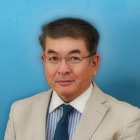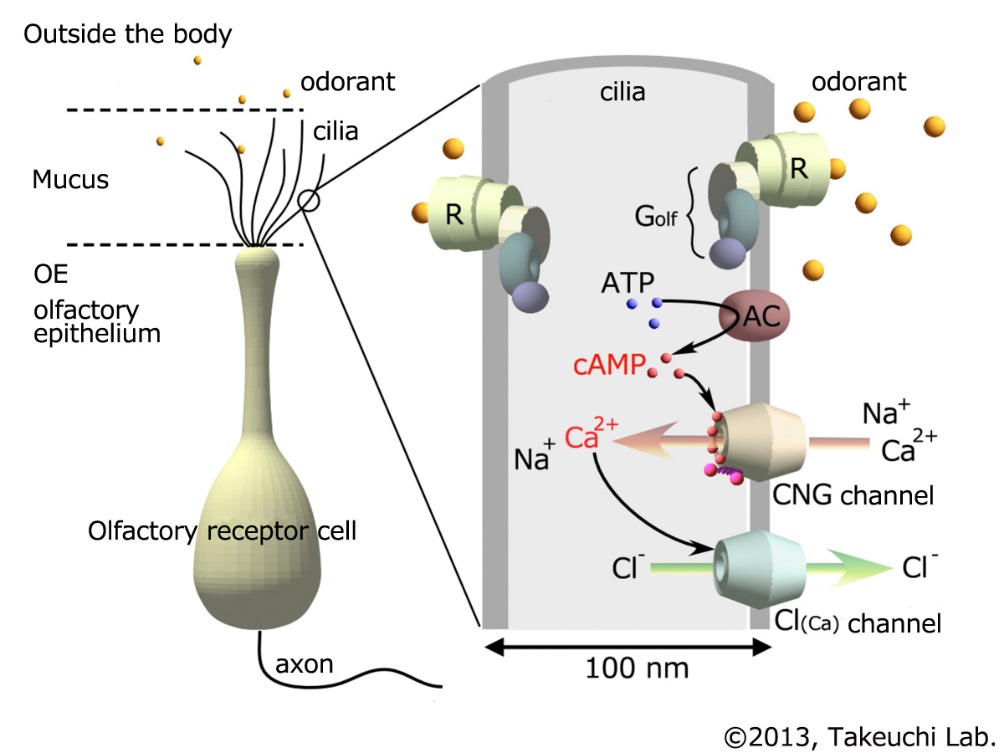Biophysical Dynamics Laboratories
Physiological Laboratory
 Prof. KURAHASHI Takashi
Prof. KURAHASHI Takashi
Keywords:
Electrophysiology, Signal transduction, Ion channel, Sense of smell
Cellular electrophysiology for the signal transduction
We are interested in cellular/molecular mechanisms of signal transduction in the nano-level structure. Our lab is especially focusing on the real time measurement of the molecular dynamics, and has expertise in electrophysiology (patch clamp), fluorescent imaging (visualization of the fine process, Ca2+ imaging), biochemistry (real time measurement of enzyme activities), photolysis of caged substances within the submicron cellular compartments, computer coding/simulation, electrical hardware (mostly, analogue circuit). One of the model systems that exhibit the nano-level structure is the olfactory cilium that has a cylindrical shape with 100 nm diameter (10 μm length). We have quantified enzymatic activities (adenylyl cyclase) in such a fine tubing, and kinetics of ion channels (CNG, and Ca2+-activated Cl- channels), dynamics of second messenger factors (cAMP and Ca2+). Quantified parameters obtained from such advanced techniques are directly linked to our sense of smell. Incidentally, in addition, we have shown the mechanism of olfactory masking, and the mechanism of cork taint in wines. Through the experiments treating such a tiny structure, we have developed techniques, and logics, soft/hard wares, and are planning to expand the newly-developed materials to broader ranges of research area employing tiny biological systems, to which such systematical analyses have not yet been applied.

Signal transduction cascade in the olfactory cilium
Members
| Takashi Kurahashi (Professor) | kurahashi.takashi.fbs[at]osaka-u.ac.jp |
|---|---|
| Hiroko Takeuchi (Associate Professor) | takeuchi.hiroko.fbs[at]osaka-u.ac.jp |
You could probably reach more information of individual researchers by Research Map and researcher's search of Osaka-U.
- ※Change [at] to @
Q&A
- What is your hot research topic?
- "Find out what you can't see"Many researchers and students seem to have the impression that electrophysiology is "difficult to understand" or "out of date". However, it would be a big mistake if you had that idea. Learning electrophysiological theory and experimental techniques can be a powerful weapon in the study of living cells. Maybe you haven't realized the importance yet. There are stages of understanding in the theory and practice of electrophysiology, like games from a superficial to a deep understanding. The essence of electrophysiology is not something that can be learned easily, so it tends to be shunned by those who like easy ways. Based on the electrophysiology we have developed over the past several decades, we can identify events that cannot be detected using only commercial products. The main theme is to elucidate ion channel activity using sensory nerve cells as samples. The olfactory receptor cells, which are used as model cells for sensory neurons, contain many attractive themes, including the activation-inactivation mechanism of ion channels densely expressed on cilia of 100-200 nm in diameter, molecular dynamics in the space of nano structure, elucidation of the input-output system, olfactory signal transduction, correspondence with human senses, and many unsolved events.
- What is your breakthrough or research progress in the last 5 years?
- The findings from olfactory studies are used in a wide range of fields, not only in basic research but also in daily life, clinical medicine, and industry. This means that the needs of society are high. Recently, the five senses have come to be regarded as the most important. The sense of smell is known as the fuzziest of all. In previous studies, it was difficult to treat olfactory receptor cells as study samples and to perform experimental procedures. However, our laboratory has been able to perform quantitative analysis by combining several techniques based on electrophysiology. We have been able to explain what we experienced in human history with numerical values and systems. Over the past five years, we have focused on molecular dynamics within nanostructures, activation and inactivation of ion channels, and sub-pA-level current analysis. Key words are olfactory transduction mechanism, transduction channels, olfactory adaptation and masking. For details, refer to our papers and books.
- What kind of background do your lab members have?
- Lab member's backgrounds vary widely, but their common denominator is electrophysiology. The patch clamp method is the minimum common understanding necessary to advance our research. Other than that, they are conducting research in a direction that takes advantage of their characteristics. For example, there are wide varieties of individual aptitudes such as machining, electronic circuitry, programming, cell handling, and photo-dissociation preparation, etc.
- Do you collaborate with other institutions and universities?
- Even if we consider both domestic and foreign laboratories, few laboratories carry out experiments of the same strain. There is more interaction with overseas laboratories than with domestic laboratories, and discussions on research and joint research can be conducted on a daily basis. It has close relations with universities in the United States, Taiwan,
Switzerland, Italy, the Netherlands, and Germany.
- What kind of careers do your Lab's alumni go on to?
- The career paths of the graduates of our laboratories are as follows: Graduate School of Medicine, Kyoto University (Currently, he is an assistant professor of the Graduate School of Medicine, Osaka University.), Suntory Holdings Limited, Shiseido Co.,Ltd., Shimadzu Corp, P&G Japan, Yamaha Corp. Takasago International Corp. Kansai Electric Power Co., Inc., and the Bank of Tokyo-Mitsubishi UFJ (Currently Mitsubishi UFJ Bank) etc.
- How do you develop your research?
- Physiological analysis can follow the living behavior of various cells in real time, and electrophysiology is an essential tool for understanding biological functions. Our laboratory focuses on ion channels and their physiology to find what we cannot see using electrophysiology from multiple perspectives. Characterization of ion channels in olfactory information conversion is one of our themes.
Research Highlights
Publications (Research Articles, Reviews, Books)
2024
Olfactory cilia, regulation and control of olfaction
Physiol Rep. 12(19):e70057. 2024 (PMID:39358841 DOI:10.14814/phy2.70057.)
2023
Segregation of Ca2+ signaling in olfactory signal transduction
J. Gen. Physiol. 155(4):e202213165. 2023 (PMID:36787110 DOI:10.1085/jgp.202213165)
2019
Suppression of olfactory signal transduction by insecticides
npj Science of Food 3:09 2019 (PMID:31304281 DOI:10.1038/s41538-019-0042-z)
Electrical properties of cells from human olfactory epithelium.
Auris Nasus Larynx 46(5):734-741 2019 (PMID:30850172 DOI:10.1016/j.anl.2019.01.006.)
2018
Second messenger molecules have a limited spread in olfactory cilia.
J. Gen. Physiol. 150(12):1647-1659 2018 (PMID:30352795 DOI:10.1085/jgp.201812126)
Our ideal candidate (as a graduate student)
We are looking for a highly motivated person to work on our research topics as our lab member. Our lab welcomes the person who loves taking care of creatures, hand working and handcraft too. Any kind of background (such as your expertise or major) is available.
Contact
Physiological Laboratory, Graduate School of Frontier Biosciences, Osaka University,
1-3 Yamadaoka, Suita, Osaka 565-0871 Japan.
TEL: +81-6-6879-7979
E-mail: kurahasi[at]bpe.es.osaka-u.ac.jp (Prof. Takashi Kurahashi)
- ※Change [at] to @
